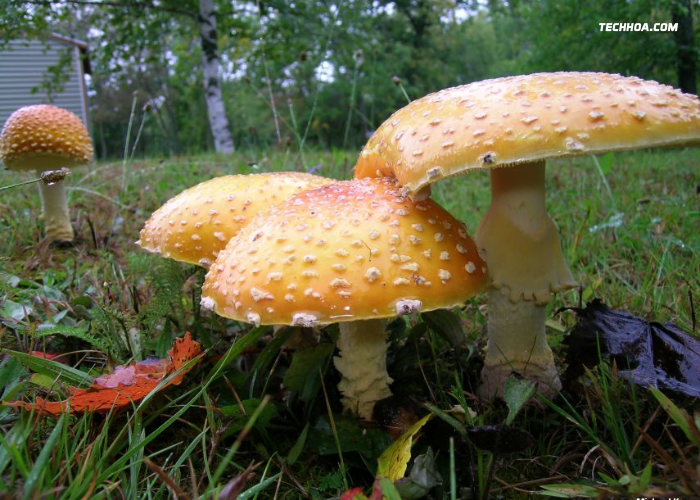Alabama, a state known for its lush forests and diverse ecosystems, is also home to a fascinating array of edible mushrooms. These hidden treasures not only provide culinary delights but also offer a unique opportunity for nature enthusiasts to connect with the environment. From the rolling hills of the Appalachian Mountains to the coastal plains, Alabama’s varied landscapes harbor a wealth of edible mushroom species, each with its distinct flavor, texture, and culinary potential.
The Art of Foraging: Ethics and Safety
Foraging for wild mushrooms can be a rewarding and sustainable activity, but it comes with responsibilities. Before embarking on a foraging adventure, it’s crucial to familiarize yourself with ethical guidelines to protect local ecosystems.
Always obtain proper permits if required and adhere to designated collection limits to prevent over-harvesting. Additionally, prioritize safety by learning to identify poisonous mushrooms and consulting expert mycologists or field guides if you’re unsure about a particular species.
Coveted Culinary Delights: Edible Mushroom Varieties
- Morel Mushrooms (Morchella spp.)
Renowned among mushroom enthusiasts, morel mushrooms are cherished for their distinctive appearance and earthy flavor. Typically found in wooded areas and along riverbanks, morels are a springtime delicacy in Alabama. Their honeycomb-like caps and hollow stems make them easy to identify. Morel mushrooms can be sautéed, added to pasta dishes, or even battered and fried for a delectable appetizer.
- Chanterelle Mushrooms (Cantharellus spp.)
Chanterelles are prized for their vibrant golden hue and delicate aroma reminiscent of apricots. These mushrooms can be discovered in the summer and fall months, often nestled at the base of trees or hidden beneath fallen leaves. With their slightly peppery taste, chanterelles lend themselves well to sautés, sauces, and risottos.
- Chicken of the Woods (Laetiporus spp.)
True to its name, the Chicken of the Woods mushroom boasts a texture similar to poultry meat. These bracket fungi can be found on decaying hardwood trees, often standing out with their bright orange or yellow coloration. Chicken of the Woods has a mild, savory flavor and is perfect for vegetarian and vegan dishes, as well as stir-fries.
- Puffball Mushrooms (Lycoperdon spp.)
Puffball mushrooms are known for their unique appearance—round, white, and often resembling small balls. These mushrooms release a puff of spores when they mature, aiding in their dispersal. They are typically found in open fields, grassy areas, and woodlands. Puffballs have a mild taste and can be sliced, breaded, and fried.
Where to Find Edible Mushrooms
Alabama’s diverse geography offers an abundance of habitats where edible mushrooms can thrive. Here are some prime locations to explore:
- Oak and Hickory Forests
The Appalachian region of Alabama, with its dense oak and hickory forests, is a hotspot for morel mushrooms. The moist, well-drained soil in these areas provides an ideal environment for more growth during the spring.
- Pine Forests
Chanterelle mushrooms tend to flourish in pine forests, particularly after summer rains. Look for them near the edges of the forest, where the trees meet open areas.
- Deciduous Woodlands
Chicken of the Woods mushrooms prefers deciduous woodlands, often growing on dead or dying trees. These mushrooms are more likely to be spotted in the fall months.
- Fields and Grasslands
Puffball mushrooms are commonly found in open fields and grassy areas. Keep an eye out for these white orbs while hiking through meadows.
A Word of Caution: Poisonous Look-alikes
While the allure of foraging for wild mushrooms is strong, it’s essential to differentiate between edible species and their poisonous counterparts. Mistaking a toxic mushroom for an edible one can have severe health consequences. Some poisonous mushrooms in Alabama include the Death Cap (Amanita phalloides) and the Destroying Angel (Amanita bisporigera). To avoid any potential risks, thorough knowledge of local species and careful identification is crucial.
The Joy of Connecting with Nature
Foraging for edible mushrooms isn’t just about the harvest; it’s also a means of connecting with nature on a deeper level. The process of seeking out these hidden treasures encourages a mindful exploration of the environment, fostering a greater appreciation for the ecosystems that sustain us. As you navigate through the woods, you’ll learn to read the landscape, noticing the subtle shifts in vegetation and the interconnectedness of living organisms.
From Forest to Table: Cooking with Alabama’s Edible Mushrooms
Bringing your foraged mushrooms to the table is a delightful culinary adventure. The flavors and textures of these wild delicacies are unparalleled. From hearty soups to elegant pasta dishes, the possibilities are endless. The key to preparing wild mushrooms is to keep it simple, allowing the unique flavors to shine.
- Creamy Morel Risotto
Infuse the earthy flavor of morel mushrooms into a creamy risotto dish. Sauté sliced morels with shallots and garlic, then fold them into Arborio rice cooked in mushroom broth. Finish with a touch of Parmesan cheese and fresh herbs.
- Chanterelle Pasta with White Wine Sauce
Create a luxurious pasta dish by sautéing chanterelle mushrooms in butter, garlic, and shallots. Deglaze the pan with white wine and simmer until reduced. Toss the mushrooms and sauce with cooked pasta and garnish with chopped parsley.
- Vegan Chicken of the Woods Stir-Fry
For a vegan-friendly option, slice chicken of the woods mushrooms and stir-fry them with colorful bell peppers, broccoli, and snap peas. Add a savory sauce made from soy sauce, ginger, and garlic.
- Stuffed Puffball Appetizer
Transform puffball mushrooms into bite-sized appetizers by removing their outer skin and stuffing them with a mixture of breadcrumbs, herbs, and cheese. Bake until golden brown and enjoy a unique, flavorful treat.
A Sustainable Approach to Foraging
Responsible foraging ensures the health of mushroom populations and their ecosystems. As you explore Alabama’s landscapes for edible mushrooms, keep these sustainable practices in mind:
- Harvest Wisely
Only collect mushrooms that you can confidently identify as edible. Leave behind young or small mushrooms to allow them to mature and contribute to the next generation.
- Use Appropriate Tools
Use a small knife or foraging scissors to harvest mushrooms, minimizing damage to the mycelium—the underground network that supports mushroom growth.
- Respect the Environment
Avoid trampling on delicate plants or disturbing wildlife habitats. Stay on established paths and be mindful of your impact on the ecosystem.
- Share Knowledge
Educate fellow foragers about ethical practices and identification techniques. Promote responsible foraging within your community.
Building a Knowledge Base
Building a solid foundation of mushroom knowledge is essential before venturing into the world of foraging. Consider these resources:
- Field Guides
Invest in reliable field guides specific to Alabama’s mushrooms. Books with detailed descriptions and clear photographs can aid in accurate identification.
- Workshops and Classes
Attend workshops or classes led by experienced mycologists. These events provide hands-on learning opportunities and a chance to ask questions.
- Online Communities
Join online forums or social media groups dedicated to mushroom foraging. Engaging with experienced foragers can help you learn from their insights and experiences.
A Final Note of Caution
While foraging for edible mushrooms can be a rewarding endeavor, it’s essential to prioritize safety and accuracy in identification. Some edible mushrooms have toxic look-alikes that can lead to serious illness or even death if consumed. If you’re unsure about the identity of a mushroom, do not consume it. Always consult expert mycologists or reliable field guides before consuming any wild mushroom.
Conclusion
Foraging for edible mushrooms in Alabama opens a doorway to a world of flavors and experiences. The state’s rich biodiversity, from its forests to its grasslands, provides a varied range of habitats where these fungi flourish. By embracing ethical foraging practices, learning proper identification techniques, and incorporating these local treasures into your culinary creations, you can immerse yourself in the wonders of the natural world while savoring the delectable delights that it has to offer. Remember, a respectful and responsible approach to foraging not only benefits your culinary endeavors but also contributes to the preservation of Alabama’s ecosystems for generations to come.






